Sharlyn J. Lauby's Blog, page 75
November 12, 2020
SHRM Instant Insights Offers HR Knowledge In a Fun Engaging Format
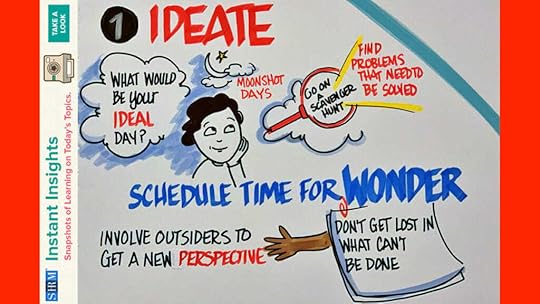
I have an admission to make. I miss conferences. One of the things that I really miss about conferences is the backchannel.
A backchannel is an online conversation that’s running concurrently to the live program. It’s a way for conference participants to engage with each other even though they are spread out around the event. The backchannel might include comments about the session like “I’m enjoying this conversation about applicant tracking systems. What vendor do you use?”. It could also include fun banter such as “I’m hungry. Anyone up for a good burger after this session?” You get the point.
The other thing that I miss about conferences is the smart stage programming. Different conferences call this type of brief session different things. But they are quick, to the point presentations about relevant topics facing the profession. I always enjoyed hanging out in the smart stage area and just listening to whoever was presenting.
The Society for Human Resource Management (SHRM) recently launched a new educational offering called Instant Insights. The program is approximately one-hour and it mashes together the two things that I miss about conferences – smart stage programming and a backchannel.
I attended the first Instant Insights program a few weeks ago and it featured speakers Jonathan Siegal, Esquire from Jackson Lewis, Dr. Milton Perkins, vice president at ActOne Government Solutions, and John Baldino, SHRM-SCP from Humareso. They talked about mastering effective communications during the pandemic, defining virtual work, and designing the workplace of the future.

The Instant Insights content was excellent and while the sessions were going on, all of the speakers were engaging with the audience via the event backchannel. I learned a lot and had fun just like I always did at in-person conferences. Oh, and if you’re SHRM certified, the event was worth 1 professional development credit (PDC).
SHRM is hosting their second Instant Insights on Wednesday, December 2, 2020. You can attend the event at 5p or 8p Eastern time. Details can be found on the SHRM website. The topics being covered include knowledge transfer, change management, and manager coaching. I know I’m going to be there. Hope you can join us!
The post SHRM Instant Insights Offers HR Knowledge In a Fun Engaging Format appeared first on hr bartender.






November 10, 2020
6 Human Experience Management Trends to Watch for 2021 #HXM

I’m confident that when we were thinking about this year during 2019 or earlier, none of us really expected it to be like this. And now that we’re approaching the end of the year, you might be saying to yourself, “I can’t wait for 2020 to be over.” I hear ya. But I think it’s important to realize that everything we’re dealing with right now isn’t simply going to disappear on January 1st.
I believe that a big part of 2021 is going to be focused on transitions. Specifically, how we – as humans – transition from where we are right now to the new normal. And how do we help the companies we work for do that?
To help us better manage transitions, it could be interesting to look at some current human experience management trends and how they will impact us right now as well as in the future. During this year’s SAP SuccessFactors Conference, these six trends were front and center.
Buy, Build, Borrow, and Bots. Given the uncertainty in the economy and job market, organizations realize they need to be more strategic with their hiring plans. When planning work and forecasting staffing, organizations are asking the questions “Is this a position we need to hire from the outside (BUY)?” “Can we train and develop a current employee to do this role (BUILD)?” “Should we engage a freelancer when we need them (BORROW)?” There’s one other question that organizations should start asking, “Is there a technology solution that could help us do this task better/faster/cheaper (BOTS)?”
Diversity, Inclusion, and Equity. Organizations realize it’s time to bring equity to the workplace. That’s great. It’s been a long time coming. Now, the focus is on doing it. Candidates and employees expect to see visible signs that the organization is living up to their words. And organizations that haven’t made the pledge, well…candidates and employees want to know “Why not?”. Diversity, inclusion, and equity is more than a program being run by the human resources department. It should be part of human experience management in company culture and embraced at every level of the organization.
Resilience. I almost hesitate to bring up the word resilience because I don’t want it to become the 2020 buzzword du jour. But the concept is so important. The definition of resilience is “the capacity to recover quickly from difficulties”. If this year has taught us anything, it’s that resilience is an essential skill – for organizations and individuals. Organizations are realizing that they need to have strategies in place to manage the unexpected. Will we be able to cover every contingency? Probably not. But when COVID-19 hit, many organizations found themselves without an emergency or business continuity plan.
Remote Work. There’s an ongoing debate about the long-term impact of remote work on company culture (and we’re going to save that conversation for another day). Bottom-line: remote work is very much a part of business and human experience management right now. Organizations and individuals need to figure out how to make it work well enough to get stuff done, not only from the standpoint of equipment and technology but being able to build positive virtual working relationships.
Self-Care. Over the past couple of years, the conversation about self-care has been increasing and 2020 put it into hyperdrive. While the title of this paragraph is self-care, we need to look at it from two perspectives. First, if we want to help others, we must know how to take of ourselves. The second point adds to the conversation about resilience (see #3 above). As humans, we need to show empathy and transparency. Empathy for individuals who are open about their needs and transparency in terms of being open about our own.
Self-Management. Think of self-management as personal accountability. Employees at every level need to know enough about themselves to understand how to be productive, solve their own problems, resolve their conflicts, manage their own learning, and navigate through changes. It’s not easy. Managers have to change the way that they support employees. Organizations need to provide development for employees to successfully self-manage. But the result is greater productivity and results.
None of these trends should be a surprise. However, for us to be successful in 2021, we’re going to have to review these human experience management trends regularly and evaluate our progress toward goals. I can see organizations and individuals tweaking their goals more often next year than in previous years. Managers and employees are going to have to spend more time having one-on-ones to discuss performance. Everyone will need to be flexible to external factors.
The key element bringing all of these trends together is human experience management (HXM). It’s about realizing that the organization is made up of humans. And that the human experience drives business results.
Image captured by Sharlyn Lauby while exploring the streets of Los Angeles, CA
The post 6 Human Experience Management Trends to Watch for 2021 #HXM appeared first on hr bartender.






November 8, 2020
Organizations: 5 Ways to Satisfy Employee Needs

I know we’re very focused on the here and now – the pandemic, the elections and runoffs, the economy, etc. Don’t get me wrong – that’s important. But we also need to take a look at some of the things we need to do long-term and start thinking about how we’re going to get from where we are right now to where we need to be.
For example, one of the trends I’ve been noticing is a huge focus on employee benefits. Yes, benefits have always been important. But with the pandemic and remote work, employees are looking at benefits differently. WorldatWork, the total rewards association for HR professionals, recently released the results of a survey that offers some insights into what employees want in their employment experience.
42% of respondents said they would take a pay cut of up to 30% and a lower job title to work from home and have more work/life balance. 54% strongly prefer that their organization take a public stance on social issues and voice opinions. 50% said they want to feel safe at work and won’t work for a company where they don’t feel safe.60% stated that it was extremely important to work for a leader who shares their values.
Just in case you’re wondering, this isn’t a “Millennial” thing or a “GenX” thing or a “Boomer” thing. The results were pretty consistent across age groups.
Honestly, none of these results surprise me. The question becomes what are organizations doing now to make sure employees feel that they work for a safe organization that speaks out, with people who share their values and support their wellbeing. Because we know it won’t happen overnight. And given that we’re dealing with a hybrid workforce (i.e. employees working both remotely and onsite) how can organizations put a strategy together that delivers to everyone. Here are a few things to consider:
Organizational mission, vision, and values. If the company hasn’t taken a look at their mission, vision, and values lately, there’s never been a more appropriate time. Organizations need to be true to their values. It’s good for employees and good for business.
Telework policies and guidelines. Even if the long-term plan is to bring everyone back to the office, the next several months could involve a combination of onsite and remote work. If you haven’t done it already, companies might want to create some guidelines on how remote work will be handled.
Workplace safety. Workplaces need to be safe. Period. We’ve always known how to keep our work environments safe, but the pandemic is forcing us to make changes. If employees are working from home, companies need to make sure employees are also doing safe things at home.
 Image courtesy of WorldatWork
Image courtesy of WorldatWork Leadership and management development. Many organizations have programs in place to develop leaders and managers, but the pandemic is adding a new requirement – being able to manage and support a remote workforce. We can’t just assume managers know how to do that effectively.
Employee surveys. More than ever, we need to check in with employees and make sure they’re doing okay. See if they need anything. Employees are still trying to figure out this “work from home” thing too. Maybe use survey technology to conduct short check-in surveys as a way to stay in touch.
All of these things: organizational values, telework, safety, leadership, and surveys are activities we should be talking about anyway. What’s different is the context. We should be asking questions about them in the here and now as well as what we want them to look like in the future. That’s how organizations can give employees what they want.
Image captured by Sharlyn Lauby while exploring the streets of New York
The post Organizations: 5 Ways to Satisfy Employee Needs appeared first on hr bartender.






November 5, 2020
Bookmark This! The Rise of Human Experience Management #HXM
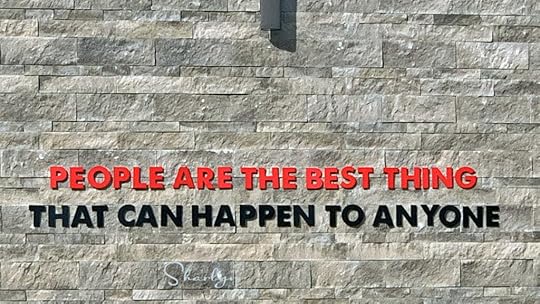
If 2020 has taught us anything, it’s that we’re human. And we want to be treated as such. This includes our work experience. Yes, we’re technically an employee or a manager or maybe a freelancer, but we want to be treated as a human.
Our friends at SAP SuccessFactors launched a LinkedIn Live series recently called “The Rise of HXM – Human Experience Management”. It’s focused on redefining work to include not just the employee experience but a human experience. The series was co-hosted by Laurie Ruettimann, founder of Punk Rock HR, Minda Harts, author of the best-selling book “The Memo”, and Lars Schmidt, founder of the consultancy Amplify.
I’m delighted that I was a part of the HXM launch team and wanted to share with you the first season. Hope you’ll check it out!
What is Human Experience Management (HXM) and Why Now?
Our friend Ron Thomas, former vice president of HR and current managing director at Strategy Focused HR, located in Dubai, talks about how human experience management (HXM) empowers businesses through their people.
In this episode, I talk with Laurie, Minda, and Lars about how companies are actively putting human experience management (HXM) into practice to build a more engaged, productive, and agile workforce. And it all starts with remembering where you started.
Recruit and Retain Top Talent with HXM
Hung Lee is the CEO of WorkShape.io and chief curator of the Recruiting Brainfood blog and podcast. In this episode, he discusses how human experience management (HXM) plays into recruiting and retaining top talent.
Support and Strengthen a Diverse Workforce
Katie Augsburger SHRM-SCP is employee experience strategist and partner at Future Work Design. She’s been responsible for designing successful HR programs and helped organizations win best places to work awards. In this episode, she breaks down the differences between inclusion and diversity.
Human Experience and the Future of Work
Jumpstart HR CEO Joey Price has been recognized as one of the “7 Startups Making Life Easier for Small Business Owners”. In this episode, he discusses what it means to support an always-learning culture, changing career paths, and the important role leadership plays in human experience management.
How to Address the Needs of Today’s Employees
Dr. Tanvi Gautam is the founder of Leadershift Inc., a global consultancy that equips leaders to be more impactful in the age of disruption. In this final episode of season one, she talks about how business leaders are adapting their workplaces to the new normal and supporting growing employee needs for health and well-being initiatives.
I know I’m stating the obvious, but the pandemic isn’t going away overnight. Organizations will have to adjust, and all of those changes aren’t necessarily bad. Rediscovering new ways of doing business can be beneficial. But one thing doesn’t change. Our employees need our support. They deserve a human experience.
Image captured by Sharlyn Lauby while exploring the streets of Gainesville, FL
The post Bookmark This! The Rise of Human Experience Management #HXM appeared first on hr bartender.






November 3, 2020
UKG Fall 2020 eSymposium: A FREE Learning Event for #HR and #Payroll Pros

(Editor’s Note: Today’s article is brought to you by our friends at UKG – Ultimate Kronos Group . Formed by two leaders in HR solutions, UKG combines the strength and innovation of Ultimate Software and Kronos. They are committed to inspiring workforces and helping pave the way for their people, customers, and industr y. Enjoy the article!)
Regular readers of this blog know that our friends at UKG have been offering a free educational event for human resources and payroll professionals each spring and fall for the past few years. And the good news is 2020 will be no exception. The UKG Fall HR and Payroll eSymposium is scheduled for Tuesday, December 1, 2020 from 10a to 4p Eastern time. As someone who has attended their events in the past, I can speak from firsthand experience that UKG delivers quality professional development that is absolutely worth your time.
I know that our plates could be very full right now with budgets, annual benefits enrollment, and sad to say, a pandemic. But now more than ever, it’s important to carve out time for professional development. Spending time at a learning event will make us even more equipped to handle today’s challenges and bring additional value to the organization. Before, I share a sneak peek of the agenda, here are three things about the event you might like to know.
Every session is recorded. There will be recordings of every session and you’ll be able to download all of the session materials. So, if you’re not able to listen to the live sessions on December 1st OR your learning preference is to space your listening out over time, then you have that option. Personally, I especially like this when there are two topics that I want to hear and they’re both being presented at the same time. With recordings, I don’t have to worry about missing out on learning.
The program has been approved for recertification credits. Let’s face it, recertification credits are important. Especially if budgets are tight (and going to get tighter). I’ll say it again – the event is free. Most of the sessions have been pre-approved by the Society for Human Resource Management (SHRM) and the Human Resources Certification Institute (HRCI). In addition, many have been approved by the American Payroll Association. And for our friends in Canada, most sessions have been preapproved by the Human Resources Professionals Association (HRPA) and the Canadian Payroll Association (CPA). UKG will be providing a certificate of participation for your files.
The content is relevant. I’ve been responsible for both human resources and payroll a few times in my career, so I like that this event brings together both payroll and HR. The eSymposium is also good way to encourage HR pros to learn more about payroll and vice versa. And because the event is free , the company can have multiple people sign up, listen to the content, and then maybe set up a virtual meeting to discuss the sessions. It’s a great way to bring the team together.
Now that you know the event is flexible, affordable, and relevant. Let’s talk about the program. The theme of this eSymposium is focused on thriving through change and resetting for the future. The sessions are organized in four tracks, “Navigating Today’s Landscape”, “Ensuring Employee Well-Being”, “Building a Culture of Inclusion”, and “Preparing for the Future”. Personally, I think the track titles are clearly aligned with what HR and payroll professionals are facing right now.
The opening keynote immediately caught my attention – “Resilience Lessons from Mount Everest: Facing Change, Challenge & Uncertainty” with Jim Davidson, New York Times best-selling author of “The Ledge: An Inspirational Story of Friendship and Survival”. I’d like to believe by now that everyone realizes resiliency is more than a learning trend du jour. It’s the thing that’s going to help our employees and organizations more forward successfully.
Speaking of resiliency, I saw a very interesting session on “Using Data to Drive Performance and Profitability During the COVID-19 Recovery” being presented by Dave Gilbertson, vice president of strategy and operations at UKG, and John Frehse, Senior Managing Director at Ankura. Numbers have always been important in business. I can’t imagine not using data to help us effectively plan our way to the new normal.
I was also excited to see Dr. Jarik Conrad on the agenda. His session is focused on “Overcoming Common Pitfalls in Diversity Initiatives”. I’ve heard him speak before and he’s great. I’m hoping he will also be sharing some of the work that UKG’s Equity at Work Council has been doing.
Lastly, UKG Senior Manager of Product Diana McGowin will be discussing “Navigating Total Rewards Offerings in a Year of Change”. Benefits have always been important but in light of what’s currently happening, I think they are even more so. With organizations trying to figure out how to manage a hybrid workforce, benefits will need to be realigned.
Of course, this isn’t the entire agenda. But hopefully, I’ve piqued your interest. The UKG Fall HR & Payroll eSymposium is designed to bring HR and payroll professionals education on the topics we deal with every day. It has the three ingredients many of us look for in a professional development event: 1) high quality content, 2) no-cost to attend, and 3) pre-approved for recertification. It’s fantastic when they’re all in a single event!
Find some time to focus on your professional development. Sign up for the UKG Fall HR and Payroll eSymposium. Here are the registration details:
UKG FREE HR & Payroll eSymposium
Tuesday, December 1, 2020
10 a.m. to 4 p.m. Eastern Time
Look forward to seeing you there!
The post UKG Fall 2020 eSymposium: A FREE Learning Event for #HR and #Payroll Pros appeared first on hr bartender.






November 1, 2020
Do Work You Enjoy – Part 2 Self Management Series
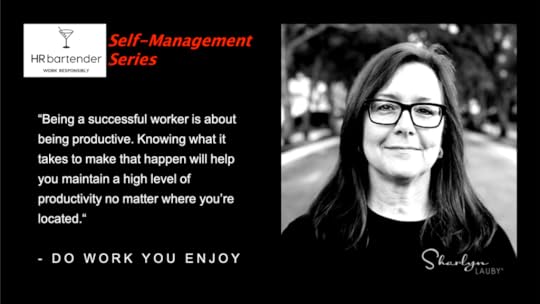
When I first became a consultant, one of the things I was really worried about was getting distracted. I had heard those regretful stories about people who work from home and aren’t able to get their work done because they get distracted by housework or other family members or lemur videos. That’s why the concept of self management is so important, especially when so many of us are working remotely.
Thinking about this from an organizational level, it’s possible that future success will be driven by the ability to manage remote workers. And part of being able to manage remote employees is knowing that those individuals can manage themselves. In the first article of this series on self management success for remote workers, we discussed the first quality being knowing yourself.
The second quality of successful self management is doing work you enjoy. There are many different ways to earn a living. Finding the way that’s right for you is key. We can spend years trying to figure out the right career. In the last article, I mentioned these two questions as a way you can learn more about yourself. You can also use them to learn more about the kind of work you enjoy.
Think about a time when you’ve felt you were at your most productive. Then list what was taking place at that time – what were you working on, what was the office environment like, who were your co-workers, etc.
By contrast, do the same thing but identify the time when you’ve felt you were your least productive. And what those elements were surrounding you at the time.
Now think of your work on this continuum, with most productive on one end and least productive on the other.
Lastly, take a moment to assess where you are right now on this continuum.
It’s possible that right now as you’re working from home, you’re trying to figure out what your job will look like in 6 months or a year from now. As you make career decisions, it only makes sense to move toward being your most productive. That’s a big part of self management.
Our careers aren’t single decisions. Most of us spend our entire lives changing and modifying our jobs to achieve that most productive state. The idea being, as we become more productive, we like our work more and the success associated with enjoying our work will come along with it.
Now, let’s add a layer to this conversation by saying you’re thinking about an upcoming meeting with your boss. Maybe the two of you will be talking about the possibility of more remote work in the future. Having a clear understanding of when you are most productive and least productive can help the conversation. You can talk about the work you’re doing in terms of productivity.
Another aspect of doing productive work is having the right environment. Using those same questions above, be sure you include on your most productive and least productive lists items such as equipment that either helped you be productive or restricted you. This could be lighting, chairs, computers, desk space, whatever… If your future work will be remote, then you want to know how to be your most productive. This isn’t just for the benefit of the company’s bottom-line. Knowing your most productive self can be important for our wellbeing.
Being a successful worker is about being productive. Knowing the exact recipe for making that happen will help you maintain a high level of productivity no matter where you are.
The third quality on the self-management success list? Well as much as we know ourselves and our work, not everything can and will go as planned…look for problem-solving next.
The post Do Work You Enjoy – Part 2 Self Management Series appeared first on hr bartender.






October 29, 2020
Bookmark This! 10 Diversity Recruitment Resources
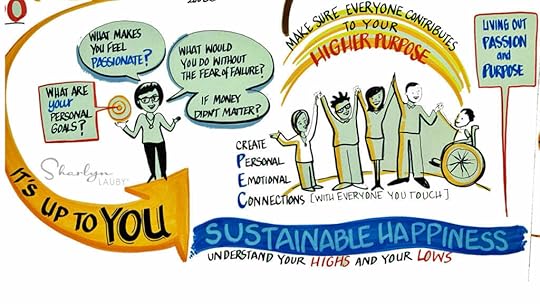
Over the past few weeks, I’ve received several notes from HR professionals looking for good diversity recruitment resources. Organizations want to reach a more diverse candidate population. They want to build diversity into their employment brand, talent networks, sourcing strategies, and hiring processes.
Here are a few resources I’ve found focused on the topics of diversity, inclusion, and equity. This is by no means a comprehensive list but hopefully, it will introduce you to some new websites and voices with that will help generate ideas that you can incorporate into your talent acquisition strategies.
Defining Diversity and Inclusion in Today’s Business Climate
Successful organizations realize that their competitive advantage is having employees who are engaged with the company. Engagement happens when employees feel they’re included. When the company is operating at its best, employees are empowered to take care of customers and enabled to solve problems and remove obstacles.
The Business Case for Diversity
In this article, author Katrina Kibben shares “There is no formula or spreadsheet for human worth. There are statistics that estimate how many people are homosexuals in the first place, how many have come out at work (or haven’t) and how many people in the LGBT community report experiencing discrimination as a result of coming out. But as far as how that impacts the business? There’s no science to that.”
10 Black HR Influencers to Follow
Wondering the best way to start increasing diversity and inclusion in your workplace? Start by actually listening to, following, and supporting Black voices. If you’re wondering who to start following, check out these amazing Black HR and talent acquisition experts and influencers.
Organizations Need to Intentionally Embrace Diversity
Every organization should create processes and philosophies that align with their culture. But the goal is to do something. Organizations cannot simply say diversity is important and then do nothing to create it. And whatever the organization says is their stand on a diverse workforce, their actions need to support their words.
Build an Inclusive Culture Before Recruiting for Diversity
When people hear the word diversity, they often think race, gender, etc. – qualities that remind you of the census demographics. Inclusion is company specific. It’s about the intentional decisions the company makes. In organizations where talent is a driver of their business, there is a huge interest in investing in diversity and inclusion.
The Right Way to Incorporate Diversity Hiring Goals and Strategies
Unfortunately, there’s no simple 10-step process to incorporate diversity into the hiring process. But there are many opportunities to successfully integrate diversity and inclusion into the hiring process. This article from the ZipRecruiter blog talks about the best practices to building diversity initiatives into recruiting.
10 Ways to Attract and Hire Diverse Candidates
Diversity hiring isn’t a passing fad — it’s a smarter way to do business in the global market. A diversified workforce is more than just an item to be checked off from your employer branding list — it a real competitive advantage. In this article, author Kristina Martic shares ten easy ways to attract diverse candidates by making your hiring process more inclusive.
5 Steps to Improve Diversity Recruiting
Bias can thwart diversity at every step of the hiring process, from recruiting, screening and interviewing to assessment and onboarding. But there are tactics that can help increase equity at each stage. Diversity hiring isn’t about one stage in a process. It’s about the more holistic area of belonging in an organization.
The Drive Between People Analytics and Inclusion & Diversity
It should come as no surprise that there is a strong correlation between diversity and a company’s financial performance. In this article, author Anthony Paradiso discusses the connection between diversity and inclusion efforts, people analytics, and the bottom-line.
5 Actions That Employers Can Take to Make Minorities Feel Valued at Work
Author La’Fanique Reed explains how diversity and inclusion efforts in organizations are both a blessing and a curse. A blessing that corporations have an interest in creating a better workplace for underrepresented groups, but there are still disconnects. This article outlines five ways organizations can take positive action.
If there are any consistent themes in these articles, it’s that diversity and inclusion isn’t an HR program. It’s a way of doing business. It needs to be ingrained into the company’s values and embraced at every level of the organization.
If you have any favorite writers or podcasters on the topic of diversity and inclusion, please share them in the comments. It would be great to put together a resource list!
Image captured by Sharlyn Lauby at the SHRM Annual Conference
The post Bookmark This! 10 Diversity Recruitment Resources appeared first on hr bartender.






October 27, 2020
Business Timing Is About More Than Getting an Approval
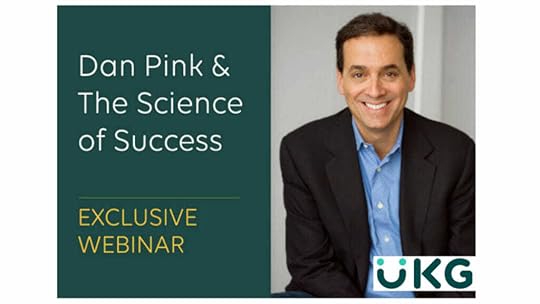
(Editor’s Note: Today’s article is brought to you by our friends at UKG – Ultimate Kronos Group . Formed by two leaders in HR solutions, UKG combines the strength and innovation of Ultimate Software and Kronos. They are committed to inspiring workforces and helping pave the way for their people, customers, and industry . Enjoy the article!)
One of the career lessons I’ve had to learn is that “timing is everything”. I remember years ago pitching the idea of casual attire to my boss. She looked at me like I had three heads. Then one day, she said to me, “You know, you’re right. We should do this.” While my timing was off in pitching the idea, a right time did happen to make it work.
As an HR pro, I’ve listened to employees talk about something they wanted. It might have been something for themselves, like a pay increase or attending training. Or maybe a manager who wanted something for their team, like new computer equipment. And no matter how many times they brought it up…the timing was wrong. I’m reminded of it now as I talk to managers who say, “I was so adamantly opposed to remote work. Now we’re doing it, granted because of the pandemic, but it’s working! And working well.”
But in talking about “timing”, it’s important to realize that it’s about more than simply having an aha moment, making a decision, or getting an approval. My takeaway from Daniel Pink’s book “WHEN: The Scientific Secrets of Perfect Timing” was that we need to think of timing as a continuous process. Timing is about creating and maintaining the right beginnings, middles, and endings.
BEGINNINGS: Getting off to a good start sets the timing.
I do believe we think about timing when it comes to beginnings. We want things to start off well. When it does, it makes our lives easier. For example, building successful relationships is essential in our personal and professional lives. You’ve probably heard the old cliché that says, “You never get a second chance to make a good first impression.” We think about beginning new relationships the right way.
Now, that doesn’t mean we don’t run into situations when relationships don’t start off on the right tone. Then of course, we have to go back and start over. But many times, those “off on the wrong foot” moments happen when we don’t put enough thought into the beginning. This is another example of the importance of a good start when we work on projects. There’s a reason those “launch meetings” are critical.
In his book, Pink suggests an activity that can help us get off to a good start – – a pre-mortem. Think of a pre-mortem as taking a moment to identify those things that can go wrong beforehand. On an individual level, an example might be remembering to listen before asking a new acquaintance for a favor. For groups, it could involve planning an icebreaker so new project team members get comfortable with each other before the work begins.
MIDDLES: Rarely, does all of our timing go exactly as planned.
I must admit, this section of the book was a real eye-opener for me. In thinking about “timing”, we often forget that projects and processes take time. And timing can play a role in keeping us interested and motivated in the work. Pink talks about the timing of middles in terms of slumps and sparks.
Slumps are those moments when progress is dragging, there’s too much negativity, and people are losing interest. We can tell that slumps are happening because employees are saying things like, “I can’t wait for this project to be over.” Or “I can’t take another setback.” Maybe attendance at team meetings is starting to wane.
Sparks are when people get excited. We might be able to see sparks because people around the organization start asking questions like “I’m hearing great things about the project. Tell me what’s going on.” Or that the project is receiving additional support “The group has made good progress. Let us know if you need any additional resources and we’ll try to find them for you.”
Realistically, there’s a good chance that we’re going to experience both slumps and sparks. Ideally, we want to find ways to turn slumps into sparks. That’s where timing comes in.
One of the activities that Pink suggests can help turn those slumps into sparks is what is known as the “Seinfeld Technique”. Comedian Jerry Seinfeld makes it a habit to write every day, not just when he feels like it. When he’s finished writing, he puts a big “X” on a calendar in his office. It’s a visual goal to never break the chain of writing on the calendar and it helps him get past those slumpy days. (Editor’s Note: If slumpy isn’t a word, it should be.)
ENDINGS: Timing our deadlines can be an effective motivator. Emphasis on the word “can”.
Personally, I like deadlines and have no problem renegotiating them if necessary. However, I do recognize that other people aren’t like me and might not view deadlines in the same way. That being said, deadlines can serve a positive purpose like the finish line in racing. They can inspire us to push a little harder to reach our goal. That’s an important part of timing – to finish on your own terms.

Speaking of finishing on your own terms, the other aspect to endings worth mentioning is that endings give us closure. Sometimes the “never quit” or “always hustle” messages can be overwhelming. It’s perfectly okay to end something for whatever the reason and start something new.
And that’s the secret to timing. Well, that’s not the only secret. But hopefully today’s article about timing makes you want to hear more from Daniel Pink himself.
Our friends at UKG will be hosting a really cool FREE webcast on Friday, October 30, 2020 featuring Daniel Pink. In the webcast, he will be discussing his insights on the science of timing and then tying it all back to the timing of the merger between Kronos and Ultimate Software. UKG will also be selecting 50 registrants at random to receive a copy of Pink’s book, “WHEN” so don’t miss out! And if you’re already booked on Friday, go ahead and sign up anyway. The session is being recorded.
We don’t always have control over timing and that’s okay. Pink’s research shows us how using the timing of beginnings, middles, and endings can help us maneuver through optimal (and less than optimal) situations. The end result is creating positive results for ourselves and our companies.
The post Business Timing Is About More Than Getting an Approval appeared first on hr bartender.






October 25, 2020
3 Topics to Include In an Employee Feedback Session
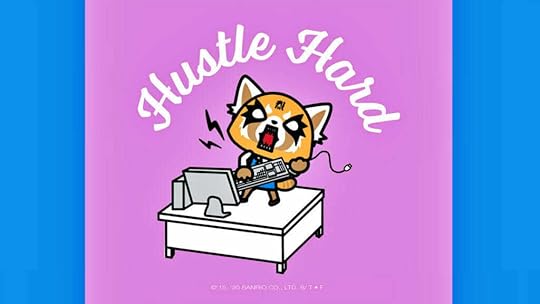
Feedback is important. If you look up the definition of feedback, it’s “information about reactions to a product, a person’s performance of a task, etc. which is used as a basis for improvement”. When I think about employee feedback, it falls into two categories:
Feedback given to the employee about their performance.Feedback provided by the employee about their reaction to a company action.
Given that the end result of feedback is improvement, I’ve always felt that organizations should provide training to employees about how to give and receive good feedback. Most organizations offer training to managers, but not always to employees. Orientation and onboarding would be an ideal time to give employees feedback tools.
One of those feedback tools could be a template or format for delivering feedback. Some of you might have seen this three-point method before. I was reminded of it recently, so I wanted to share. What I like about it is that it’s easy to remember, so hopefully that means people will use it.
START: One of the principles in adult learning is to tell people what’s in it for them (aka the WIIFM). It seems to me that this is the concept of START. Share with another person what you’d like for them to do and why you’d like for them to do it. Of course, the WIIFM can’t be “because I said so” or “otherwise you’ll be written up or fired”. That’s why it’s important to really think about the START topic. On some level, it’s easy to tell people what to do. The hard part is explaining why in a way that makes someone want to do it.
STOP: It might be tempting to lead the discussion with STOP, but I’m not so sure about that. It might put someone on the defensive. If you begin the conversation with START, hopefully the person will already understand what needs to STOP. For example, you can say to an employee “I’d like to see you submit your expense reports on Thursdays so you can get paid faster.” This implies that submitting them on whatever day they’re currently being submitted should STOP.
CONTINUE: To me, this is the topic where we can reinforce something that the employee already does well. Using the expense report example, maybe the employee does a great job with the detail and explanations. The conversation is only about the day the report is submitted. This is also an opportunity for employees to give managers some feedback about their role. Maybe something like, “You do a great job of approving my expense reports within 24-hours. Thanks!”
The goal of this conversation is to talk about what a person should START doing, what they should STOP doing, and what they should CONTINUE doing. It’s not about disciplinary action. This type of feedback happens all the time in organizations. Especially when policies or procedures change.
Also keep in mind – and I think this is the great part about using this method – that as one person talks about START/STOP/CONTINUE, the other person might have a related START/STOP/CONTINUE to add. For instance, if the manager asks an employee to start submitting expense reports on Thursdays, the employee might ask for the manager to stop asking for another report on the same day. Ultimately, both people negotiate and agree on the best START/STOP/CONTINUE for the situation.
Feedback is an essential communication tool. It involves two-way communication. Having a consistent way to deliver feedback can benefit everyone, which creates improvement. And that’s the goal.
Retsuko image from Aggretsuko anime television series.
The post 3 Topics to Include In an Employee Feedback Session appeared first on hr bartender.






October 22, 2020
MOCHA: An Alternative to RACI for Organizational Accountability

A few years ago, I wrote a piece about “Using RACI to Improve Organizational Teams”. RACI is an acronym that stands for responsible, accountable, consult, and inform. It’s a way to establish accountability.
I mentioned RACI in a training program recently and someone said they use a similar acronym called MOCHA. I – along with several other people – immediately said we were stealing this one. Here’s what MOCHA represents:
Manager: Who handles the day to day management of the task or program? Someone has to be responsible for the work – whether that’s a task, process, program, etc. They handle the everyday decisions and coordinate the front-line activities associated with the job.
Owner: Who is the organizational owner or sponsor for this task or program? Depending upon the type of work we’re referring to, this person might be a senior leader who directs a department or division. Or maybe it’s someone that has a lot of influence in the organization, so we want them to be kept in the loop.
Consultant: Who advises the group or manager? This could be an internal or external subject matter expert. They might have a regular role or be someone who is called in to deal with a specific problem or obstacle.
Helper: Who are the people that the group or manager taps into for information or assistance? There are always people who help us accomplish our work. They might not be in our department. They might not be on our project team. But we need them for data, information, and sometimes just a supportive ear.
Approver: Who approves resources for the manager or group? This may or may not be the owner. The approver could be someone in purchasing or procurement. Or maybe they’re the CFO. We need both owners and approvers to be successful.
I thought the MOCHA acronym was a refreshing take on the traditional RACI acronym. I particularly liked the addition of the helper category. I don’t know that organizations spend enough time thinking about the help they might need to accomplish a goal. Not only does this help the group focus on those resources but it provides a way for those “helpers” to be acknowledged for their contribution.
The other thing that I liked about MOCHA is that this organization took a concept like RACI and made it work for them. That’s what best practices bring to the table. It’s not always about copying what someone else is doing. It’s about saying, “I like that idea. How can I make it work for me?” New ideas are formed all the time.
Most importantly, MOCHA still focuses on establishing accountability for a task or program!
Oh, and I would be totally remiss if I didn’t mention that MOCHA could be fantastic from an internal marketing perspective. Think about all of the MOCHA you could include in a project launch meeting. It just writes itself. And it helps the organization perform at a higher level.
Image captured by Sharlyn Lauby outside the Museum of Chocolate in Havana, Cuba.
The post MOCHA: An Alternative to RACI for Organizational Accountability appeared first on hr bartender.






Sharlyn J. Lauby's Blog
- Sharlyn J. Lauby's profile
- 10 followers



